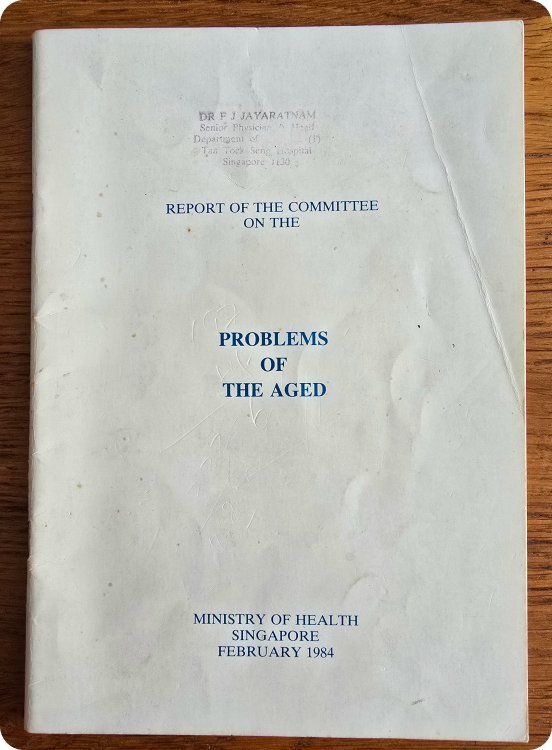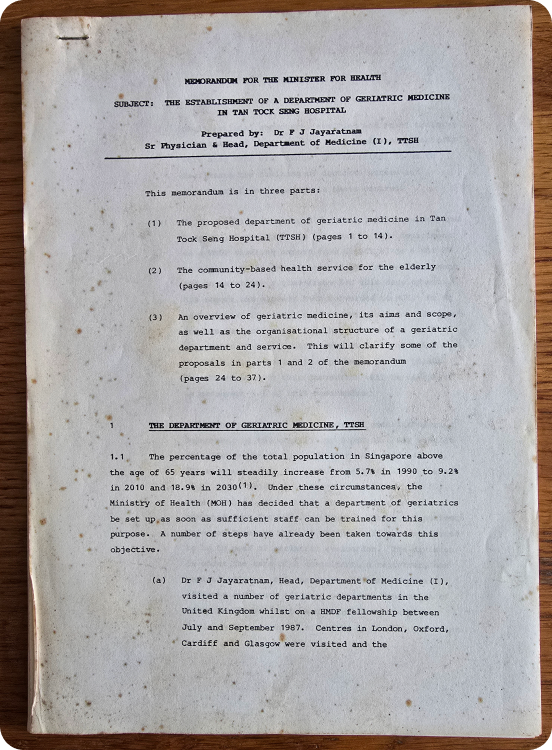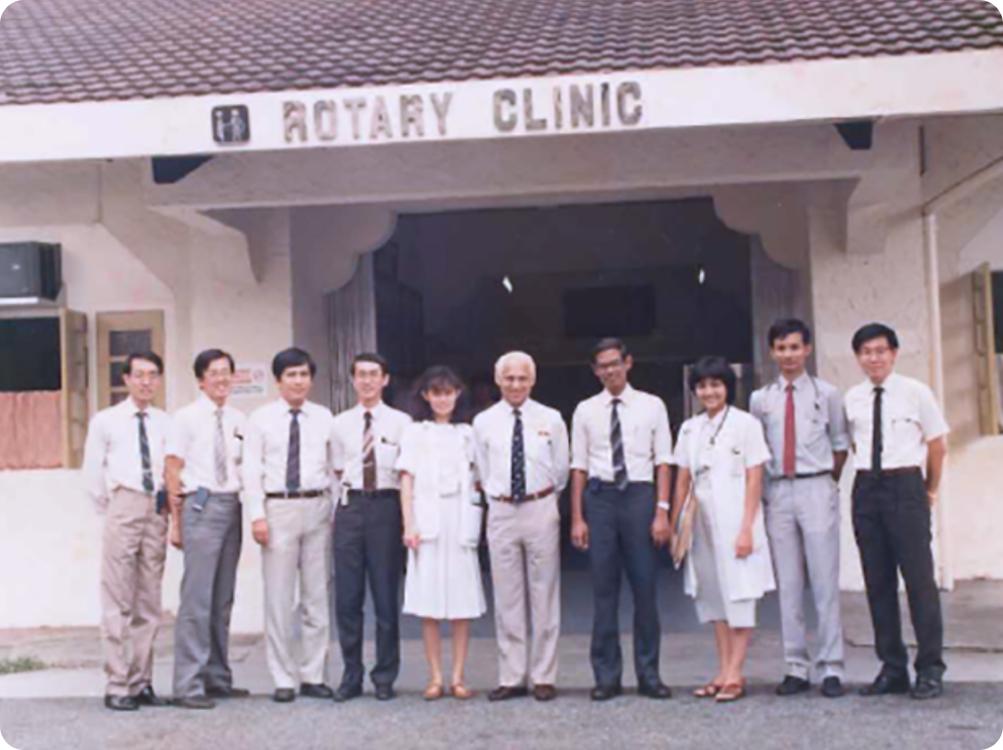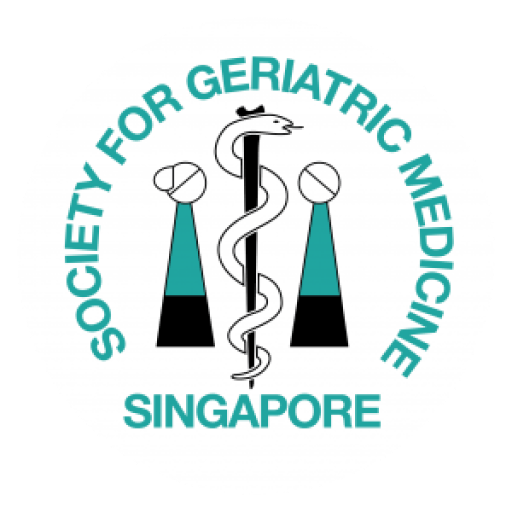Geriatric Medicine in Singapore
The Beginning of a Legacy
Recognizing the unique medical needs of older adults, these pioneers aimed to create a dedicated platform for advancing geriatric medicine, fostering education, and supporting research in this rapidly evolving field.
-
1982
Cornerstone of Geriatric Care
The flourishing of Geriatric Medicine in Singapore was one built upon decades of great foresight and dedication. The need for geriatric services was first recognised in 1982 when then Health Minister Howe Yoon Chong launched the Committee on the Problems of the Aged in accordance with Singapore’s rising life expectancy and growing ageing population.

Report of the Committee on the Problems of the Aged, Ministry of Health Singapore. Credit: Prof Pang Weng Sun.
To ensure good geriatric care for the nation, Dr Francis Joseph Jayaratnam, then Head of Medical Unit 1 in Tan Tock Seng Hospital (TTSH), was tasked to pioneer a comprehensive geriatric service in Singapore. He visited geriatric services in the UK and linked up with the British Geriatrics Society to have local trainees sent to the UK for specialist training.

Memorandum for the Minister for Health to Establish A Department of Geriatric Medicine in Tan Tock Seng Hospital. Credit: Prof Pang Weng Sun.
-
1988
Training of Geriatric Medicine Specialists
From 1988, Internal Medicine trainees were sent to Geriatric Medicine Departments in Glasgow, Edinburgh, Cardiff, Newcastle, Southampton, London, and subsequently to Australia, the US and Hong Kong for further training.
Geriatric Medicine Departments were set up in TTSH (1988), Alexandra Hospital (AH; 1994) and New Changi Hospital (1998); later renamed Changi General Hospital (CGH).
Soon after, geriatric services expanded with help from pioneer geriatricians including Prof Philip Choo, Dr Pang Weng Sun, Dr Ee Chye Hua and Dr Chan Kin Ming. In the years that followed, Geriatric Medicine Departments were established in all of Singapore’s public hospitals, with further expansion of geriatric services into the domains of primary care, palliative care, and community care.

The first-ever Department of Geriatric Medicine in Singapore at TTSH with 71 patient beds, 2 consultants and 3 registrars in 1988. Prof John Pathy, Geriatrician and HMDP Visiting Expert from Cardiff is on the right of Dr F Jayaratnam (Dr Philip Choo was overseas on HMDP at time of photo).
-
1990s
Progress in the Geriatric Care Landscape
Health Services for the older people evolved into the Department of Continuing Care in MOH, with special attention to fund support services and elevate standards of care. Concurrently, MOH continued training geriatricians and gerontology nurses, and set up polytechnic programmes to train allied health professionals including physiotherapists and occupational therapists. To ease coordination of healthcare services across Singapore, MOH clustered and placed these services geographically under three Co-ordinating Committees for Geriatric Care (CCGC-West, CCGC-North, CCGC-East) with Geriatric Medicine departments in AH, TTSH and CGH respectively. These were later re-named Co-ordinating Care Networks (CCN) to include the community hospitals and other community services within each sector. These preceded the re-organisation of Singapore’s healthcare services into the current 3 clusters.
Meanwhile, formal geriatric training programmes were established in Singapore’s public healthcare system. In the early 1990s, the Basic Specialist Training (BST) and Advanced Specialist Training (AST) formed the core of postgraduate medical training in Singapore until 2010, when the Accreditation Council for Graduate Medical Education-International (ACGME-I) Residency Programme was adopted nationwide. Specialist training was allocated based on Singapore’s three healthcare clusters (NHG, NUHS and SHS) with cross-cluster rotations and combined National Didactic Teachings to ensure co-learning and development of friendships within the nation’s geriatric community. Subspecialty tracks were developed within Geriatric Medicine, comprising Dementia, Falls, Continence, Community, and Palliative Care. Geriatric Medicine was also established as a core module in both undergraduate and postgraduate training across all medical schools and public hospitals in Singapore.


Geriatric Medicine trainees at the SGMS Debate held in conjunction with the 9th Asian Conference for Frailty and Sarcopenia, 2023.
-
1996
Empowering more in Geriatric Care
Meanwhile, the need for geriatric care beyond Geriatric Medicine specialists was recognised and this led to the launch of the Graduate Diploma in Geriatric Medicine Programme [GDip (Geri Med)] in 1996, in collaboration with the Division of Graduate Medical Studies, Yong Loo Lin School of Medicine, National University of Singapore, and Family Medicine, to equip primary care physicians with basic skills in caring for older adults. Today, the GDip (Geri Med) remains a highly-subscribed postgraduate training programme and is synonymous with SGMS’ vision in expanding and improving geriatric care in Singapore. -
1996-Present
Growing from Strength to Strength
As the number of geriatricians increased, the Society for Geriatric Medicine Singapore (SGMS) was set up in 1996 to enhance education and professional development, with Dr Ee Chye Hua (the most senior amongst us) as the first President. In the Academy of Medicine – the Chapter of Physicians, originally formed in 1966, was transformed into the College of Physicians in 2004 and this also led to the formation of the Chapter of Geriatricians, together with other medical speciality chapters.
Geriatric Medicine has indeed come a long way since its first launch in Singapore in 1988. As our population ages, SGMS and the Geriatric Medicine community hope that we can collectively continue to provide good geriatric care for the people of Singapore.
